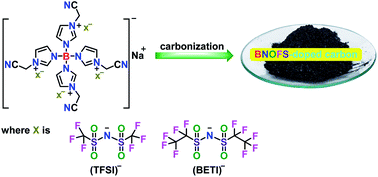De novo fabrication of multi-heteroatom-doped carbonaceous materials via an in situ doping strategy†
Abstract
Finding a succinct strategy to fabricate multi-heteroatom-doped nanoporous carbonaceous materials is a long-term challenge and highly desired research topic. The key to success is the rational design of easy to obtain and functionalized precursors. Herein, de novo fabrication of carbonaceous materials doped with multiple heteroatoms namely boron, nitrogen, oxygen, fluorine, and sulfur was achieved via a one-step in situ doping procedure using task-specific ionic liquids (TSILs) as precursors. Our strategy hinges on the adoption of particularly designed TSILs with structures functionalized with (1) boron source-containing anions, (2) imidazolium functionalities as the carbon and nitrogen source, (3) nitrile groups capable of trimerization during the heating process, and (4) bis(trifluoromethanesulphonyl)imide and related anions performing as the source of heteroatoms (i.e., fluorine, nitrogen, sulfur, and oxygen) and porogens. The unique structures of the as-prepared TSILs make them qualified precursors for the production of multi-heteroatom-doped carbonaceous materials through simple thermal treatment, with surface areas up to 1021 m2 g−1. The introduction of multiple heteroatoms provides the carbonaceous materials with efficient adsorption performance for the capture of hazardous anionic pollutants, dyes, and neutral organic molecules. This finding expands the versatility of TSILs with multi-functionalized architectures, delivering nanoporous materials with wide applications.



 Please wait while we load your content...
Please wait while we load your content...
